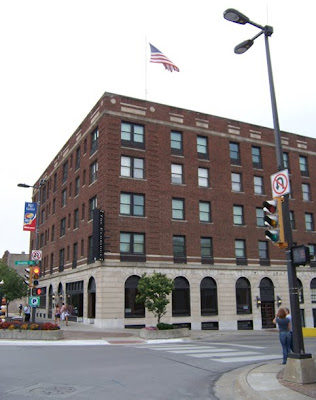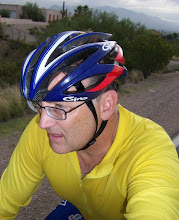
Named after a judge Lecompte--who rallied residents for Kansas to be a Slave State.
Lecompton was a destination that we tried to reach a few weeks ago but we ran out of time--plus the wind was bearing down on us so we had to turn back. With better weather, and an early start, I set out for the old Kansas Territory Capital of "Slave Kansas."
Many people wanted Kansas to come into the Union as Slave --others wanted Kansas a Free State. When it looked like KS would be a Free State after all, folks picked up and moved to Topeka. Lecompton withered--but there still remains pre-Civil War divisions in the air even now.
Crossing the Kansas River at Lawrence--what's left of some old manufacturing plants from the the 1870's. The Great Flood of 1903 destroyed all that industry and it was never rebuilt.
On the bike you head out of Old Historic Downtown, cross the River, and soon ride into lines drawn between pre-Civil War ideologies. Lawrence and Lecompton were competing for what was hoped would be a lucrative steam boat spot on the Kansas River. When the river proved mostly un-reliable because of low water levels, both towns struggled. When the rail line finally reached Lawrence after the Civil War, fortunes changed for Lawrence.
Grain Elevator in Old North Lawrence across the river.
I'll be taking Hwy 24 North and then West to Lecompton--and then circle back on the Old Farmer's Turnpike to this Grain Elevator and rail hub. This is where the farmers have brought their corn and grain to ship to markets for over 150 years.
Fertile green fields of America's Heartland.
Old School House built in 1869 on Hwy 24 Heading West.
The Civil War between the North and South ended when the North destroyed the South militarily and culturally. Kansas was Free--to keep it free, education would be high on the list for the new residents to supplant any notion of a Slave State--school houses are everywhere out here.
The Civil War between the North and South ended when the North destroyed the South militarily and culturally. Kansas was Free--to keep it free, education would be high on the list for the new residents to supplant any notion of a Slave State--school houses are everywhere out here.
Farm House from those days aging gracefully.
A tailwind helping me along at a good clip, mes amis!
With the wind in my favor, I cut through the cool morning air West on Hwy 24--the Hwy follows the base of the bluffs, and I pass emerald green landscapes--glowing with corn fields and thick green grass . I was making good time, Gentle Reader of This Blog, and stopped at the historical marker below, just before the small village of Perry.
Click on the photo to read the marker as it will be larger.

Perry High School, and those endless miles of cornfields I ride past!
I found an open restaurant in Perry! On a Sunday morning! But I did not stop in today--maybe next time.
In Perry, I stopped a local fellow out getting his morning paper and asked for some directions. He said I was on the right road--keep going, then over the Kaw, then "Lee Compton" as I hear people say the name. I think people believe the town was named after a guy named Lee.
In Perry, I stopped a local fellow out getting his morning paper and asked for some directions. He said I was on the right road--keep going, then over the Kaw, then "Lee Compton" as I hear people say the name. I think people believe the town was named after a guy named Lee.
Riding down this road that will take me into old Slave Kansas...
I'll cross the river into Lecompton here at the old ferry crossing. I get an eerie feeling because had I been riding out here in 1858, I may not have been welcome.
My great great grandfather was living in Highland, Kansas Territory--about 90 miles North-east on the Kansas-Missouri border (Near St. Joseph, MO.) and I don't know what their feelings were on the matter. I believe, deep down in my blood, that they were for Free Kansas.

Over the Kansas River.
Lecompton High School.
Lecompton was a nice place--but I didn't want to stick around and explore. Mainly because to ride into the older historic part of town, I'd have to climb some hills. Just was wanting to get back to Lawrence--I'll save that exploration for next time.
"You a Jayhawker, there Pilgrim?" Cattle eye me with suspicion, even now, after the War Between the States mes amis!


438 is what's known as the Farmer's Turnpike.

Heading East on the Farmer's Turnpike--an old historic route for taking crops to market and the rail hub back in Lawrence.
Occasionally, I-70 would come into view. Cars streaming past endlessly it seemed. Driving to Kansas City from about where I am only takes about 30 minutes...
From another time--a school house built in 1869.

A Rural Volunteer Fire Station on the Farmer's Turnpike--if need be, they can get right on I-70 to help out in emergencies.
Tractor and Port-a-John.
I used the Port-a-Pottie--or Port-a-John as they're sometimes called, which was being guarded by this old tractor. I would say that it was almost an old rust-bucket--its main job mowing this field.

The Farmer's Turnpike ends here at one of the grain stations--now quite modern.
Back in Lawrence.
The problem with this ride is that there's no fast way through the Northwest side of old Lawrence. I'm having to ride through the old streets that hug the Kansas River Banks--then I have to cross busy 6th Street, or ride on it about a mile. Traffic is heavy!
Downtown! The Ethridge Hotel built in 1858.

Heading East on the Farmer's Turnpike--an old historic route for taking crops to market and the rail hub back in Lawrence.
My tail wind didn't last--now a bit of a cross wind--still I rode well and enjoyed the fact that there was no traffic out here at all. I wondered what it would have been like on a horse, or pulling a team loaded with grain? It would have been about an 8 or 9 mile trip.

Interstate 70 runs along side the Farmers Turnpike for several miles.
Occasionally, I-70 would come into view. Cars streaming past endlessly it seemed. Driving to Kansas City from about where I am only takes about 30 minutes...
From another time--a school house built in 1869.

A Rural Volunteer Fire Station on the Farmer's Turnpike--if need be, they can get right on I-70 to help out in emergencies.
Tractor and Port-a-John.
I used the Port-a-Pottie--or Port-a-John as they're sometimes called, which was being guarded by this old tractor. I would say that it was almost an old rust-bucket--its main job mowing this field.
As not a lot of these old roads are used, sometime the maps lack a few details. I think this is about where I am.

I pass the power plant that allows me to have electricity to have this computer and write this blog, Gentler Readers.

The Farmer's Turnpike ends here at one of the grain stations--now quite modern.
Back in Lawrence.
The problem with this ride is that there's no fast way through the Northwest side of old Lawrence. I'm having to ride through the old streets that hug the Kansas River Banks--then I have to cross busy 6th Street, or ride on it about a mile. Traffic is heavy!
Downtown! The Ethridge Hotel built in 1858.




















No comments:
Post a Comment